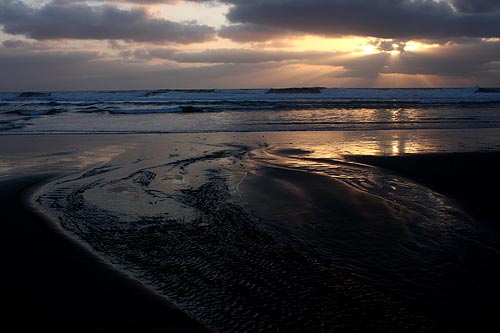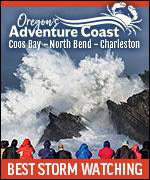Oregon Coast Science: What Are Those Shafts of Sunlight / Fingers of God?
Published 05/17/2017 at 5:23 AM PDT
By Oregon Coast Beach Connection staff
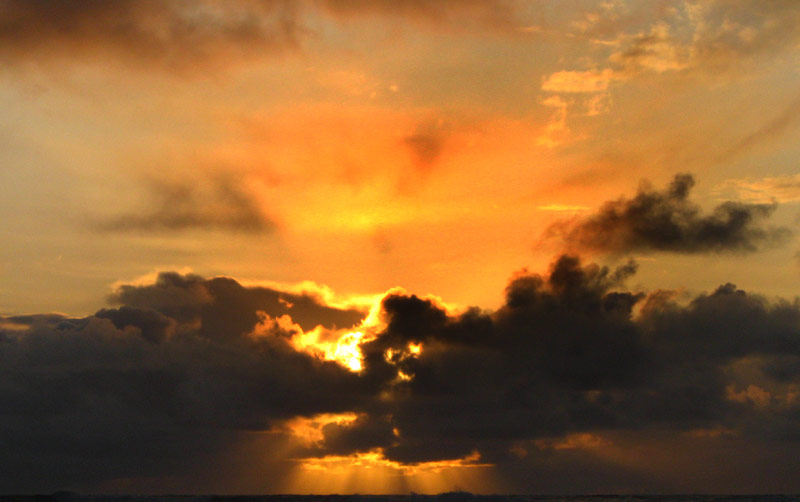
Includes exclusive listings; some specials in winter
In Cannon Beach:
Includes rentals not listed anywhere else
In Manzanita, Wheeler, Rockaway Beach:
Some specials for winter
In Pacific City, Oceanside:
Some specials for winter
In Lincoln City:
Some specials for winter
In Depoe Bay, Gleneden Beach:
Some specials for winter
In Newport:
Look for some specials
In Waldport
Some specials for winter
In Yachats, Florence
Some specials for winter
(Oregon Coast) – Those mysterious shafts of sunlight in the sky on somewhat cloudy days on the Oregon coast can make an enormous impression. Sometimes called sunbeams, angel lights or the Fingers of God, they appear with a resounding sense of the awesome and the astonishing, reminiscent of something heavenly.
What are these freakishly beautiful, magnificent shafts of light in the sky?
Indeed, their origins are much more down to Earth. Well, it's a mix of heaven and Earth, actually.
They are called crepuscular rays (try saying that fast three times). The term crepuscular means “pertaining to twilight,” and they mostly happen around sunset or sunrise.
According to Treena Jensen, a meteorologist with the National Weather Service in Portland, it's a matter of particulates in the atmosphere getting illuminated by a break in the clouds, and then a curious optical illusion kicking in after that.
“It's related to the twilight rays that kind of peek through what seem to be holes in the clouds at sunrise and sunset, so the rays appear to converge outward from the setting sun,” Jensen said. “And they're only visible when there's enough haze and dust in the atmosphere so the areas not shadowed from the clouds can be scattered towards the observer.”
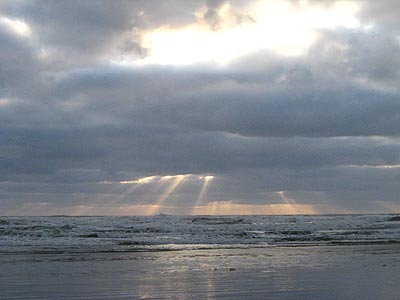 In essence, this means that first there has to be the sun hanging at a low angle, and then some sort of stuff in the air between you and it. The waning (or waxing) sun is already colored and tinted by the layers of atmosphere laying between you and it, causing those wild oranges, purples, yellows or whatever.
In essence, this means that first there has to be the sun hanging at a low angle, and then some sort of stuff in the air between you and it. The waning (or waxing) sun is already colored and tinted by the layers of atmosphere laying between you and it, causing those wild oranges, purples, yellows or whatever.
From there, the lower angle of the sun lights up the particulates in the air and they come out as shafts or rays of some sort.
Here's the kicker: crepuscular rays are actually straight and parallel. Photos from space have shown them to be just that. So why do they come out bent at angles?
“The rays look like they're diverging outwards, but they're actually parallel from each other,” Jensen said. “They appear to diverge due to perspective. So it's the same thing as looking down a railroad track: the tracks closer to you appear to converge at a distant spot because of perspective. All that dust and haze give that appearance that they're converging towards the sun.”
It's the low angle of the sun that creates that diverging / perspective effect. If it is illuminating stuff in the air from a lower level, the observer sees that stuff in the same way he or she would see railroad tracks. This is why the shafts of light can appear at all sorts of wacky angles.
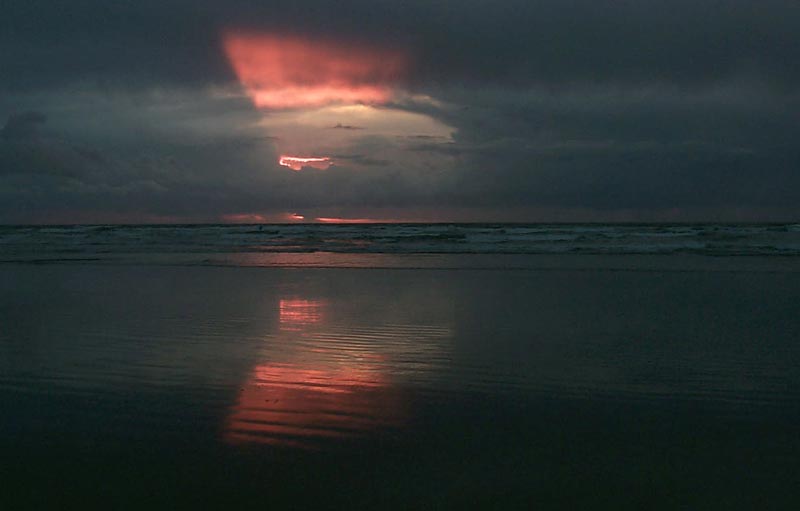
In the case of this shot in Seaside taken in 2004 (above), the hole in the clouds is above where the sun is. That means the divergence would point upwards.
This effect doesn't necessarily mean Oregon coast skies are polluted, either. Jensen said while dust, pollution and even fires from a distant land are a factor (the wild red skies in August of 2015 on the coast were caused by major fires in Russia), often it's the ocean that's the big cause.
“Salt spray from ocean waves sometimes produces that,” Jensen said. “It's a somewhat polluted environment, but not the pollution you normally think of. It's a natural pollution. Especially on a windy day when there's pretty big surf that can cause a lot of sea spray.”
The crepuscular rays don't just happen on the ocean air of the Oregon coast by any means. They happen about as often inland as well, Jensen said.
“Usually it's around mountain peaks,” she said. “Although most associate it with the coast.”
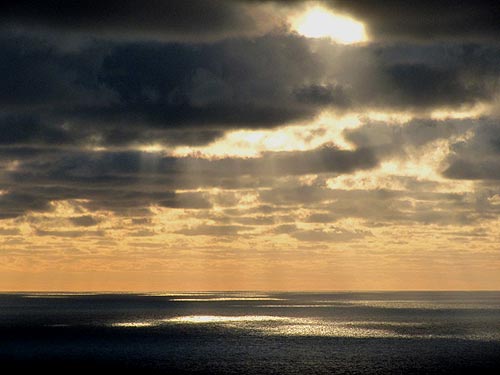
In this shot at Manzanita, you can see the shafts running much more
parallel.
Even crazier, science has noted a phenomenon called Anticrepuscular rays, which happen on occasion in conjunction with the the crepuscular rays. These are converging rays of light that are opposite where the crepuscular ray phenomenon is taking place: at the other end of the horizon. They appear as much fainter rays that appear to converge on the complete other side of your view. If you see the regular crepuscular ray effect, turn around and look carefully behind you.
This probably doesn't happen as much on the Oregon coast because the coast range mountains are closer. But this can be seen in the valley portions of Oregon. Oregon Coast Hotels in these areas - Where to eat - Maps - Virtual Tours
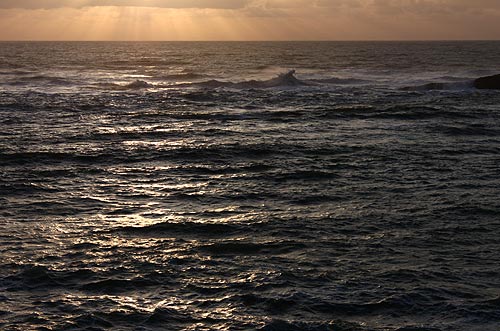
More About Oregon Coast hotels, lodging.....
More About Oregon Coast Restaurants, Dining.....
Cannon Beach Lodging
Nehalem Bay Lodgings
Manzanita Hotels, Lodging
Three Capes Lodging
Pacific City Hotels, Lodging
Lincoln City Lodging
Depoe Bay Lodging
Newport Lodging
Waldport Lodging
Yachats Lodging
Oregon Coast Vacation Rentals
Oregon Coast Lodging Specials
LATEST Related Oregon Coast Articles
Incredible situations and adrenaline-pumping images. Weatherd
Outstanding Hotels / Places to Stay at Gold Beach: Quirky Gems of S. Oregon C...
Gold Beach boasts a lot more than many may know. Gold Beach hotel reviews
Historic North Oregon Coast Inn Gets New Life as Off-the-Beaten-Path Forest G...
Nehalem River Inn is nearly 100 years but has a new look. Manzanita hotel reviews, Manzanita lodging
Sea Lion on Oregon Coast Dock Humanely Euthanized After Shark Takes Piece Out...
It had been lanquishing in pain on a Newport dock for awhile. Marine sciences
Yay For More Daylight: Sunset is Now Past 8 pm for Oregon, Coastline
Tonight Portland sees sunset at exactly 8 p.m. Weather
S. Oregon Coast Lighthouse Behind a Curtain: Cape Blanco Temporary Lamp, Gift...
Different, temporary light source for a time in front of a curtain. History, Port Orford
Puffins Have Returned to Oregon Coast, Especially Cannon Beach
Seen at Haystack Rock and around Bandon. Marine sciences
A Deeper Dive into Oregon Coast's Dungeness Crabs at Netarts Bay, April 28
Friends of Netarts Bay WEBS puts on the event. Oceanside events, Garibaldi events, Pacific City events
Back to Oregon Coast
Contact Advertise on BeachConnection.net
All Content, unless otherwise attributed, copyright BeachConnection.net Unauthorized use or publication is not permitted























